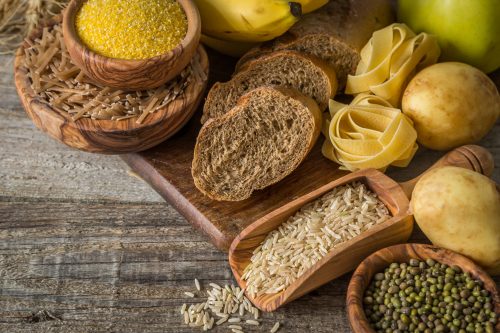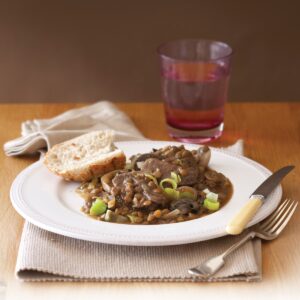
Are you suspicious of carbs? Looking at a low-carb diet to lose weight? Dietitian and author of Eat to Beat Cholesterol and Food Myths Nicole Senior explains that not all carbs are equal, and some may even help you lose weight.
We know that cakes, biscuits and soft white bread are high in carbs. And so are hot chips, potato chips and flaky pastries. If you find that these foods are derailing your good health intentions, it seems logical that quitting carbs might be the answer.
You might have also heard so-called fitness gurus talk about how you can ‘burn fat’ and shed weight fast if you deprive your body of carbohydrates. Are they telling the truth? Well, yes and no. And we’ll explain why in a minute.
The most important thing to understand is that not all carbs are created equal, and the right kinds of carbohydrates can help you lose weight, keep it off and ensure you get longer-lasting satisfaction from your meals. We’ll show you which ones these are. But, first, let’s go back to nutrition basics.
What are carbohydrates?
Carbohydrates are one of the main nutrients in our diet, the others being protein and fat. There are three main types of carbohydrates found in food: sugars, starches, and fibre. Your body needs carbohydrates to function properly. Sugars and starches are broken down by the body into glucose (blood sugar) to be used as energy. Fibre is the part of food that is not broken down. It helps you to feel full and can help you maintain a healthy weight.
Why do we need carbs?
So we can enjoy freshly baked bread! Seriously though, carbs are our body’s basic fuel — like petrol in a car. When digested, carbs are broken down into the simplest form of sugar — glucose — used by the body as energy. Glucose is the main source of fuel for the brain and muscles.
How many carbs do we eat?
The amount of carbs in a healthy diet can vary. Most of us don’t overdo the amount of carbs we eat, but we could do better on quality. The last national nutrition survey (2008–09) of New Zealanders found that, on average, 14 per cent of reported daily kilojoules come from foods like pies, cakes, biscuits and pastries, which are high in carbs but low on nutrients. To put this in perspective, that’s around 1200kJ out of an 8700kJ day from low-quality carbs.
Carbs and weight
Restricting kilojoules results in weight loss, regardless of whether you cut carbs, fat or protein. In fact, when diets low in carbs were compared with diets not low in carbs, some studies found the amount of weight lost was the same.
Cakes, biscuits and sugar-sweetened soft drinks are high in carbs. But they’re also high in fat, sugar and, importantly, kilojoules. So when people lose weight by cutting these foods from their diet, they often wrongly attribute the weight loss to being on a low-carb diet.
But there are other high-carb foods which don’t carry the extra fat and sugar, such as lentils, grains and starchy vegetables. Instead they’re loaded with fibre and a raft of vitamins and minerals. So clearly not all high-carb foods are the same.
Bread cops a bad rap too, but white fluffy bread is very different to dense wholegrain loaves with visible seeds and grains. Similarly, a puffed rice breakfast cereal is high in carbs, but so is a bowl of nutritious muesli. There’s good evidence to show that people who eat a lot of whole grains weigh less than those who eat very few. It’s not cutting all carbs that helps you lose weight, it’s the types of carbs you cut that does the trick.
Low carb vs slow carb
Just as your car runs better on quality fuel, your body runs best on high-quality carbohydrates. These include whole grains such as barley and quinoa, high-fibre cereals, beans and legumes, fruit and cooked and cooled potatoes (cooling changes the starch structure, lowering the GI).
We call these slow carbs because our body digests them slowly and they provide long-lasting energy. They are also called low-GI foods. The Glycaemic Index (GI) measures the rate at which carbs are digested. High-GI foods (think white bread or quick-cook white rice) are digested quickly.
Choosing low-GI carbs keeps you full for longer, which helps with weight control. Low-GI carbohydrates also help to manage blood glucose and insulin levels which, in the long term, help to reduce your risk of developing type 2 diabetes and heart disease.
Do low-carb diets really work?
Yes, for some people, just as other diets where energy (kilojoules) is restricted do. A low-carb diet is usually defined as being below 100g of carbs a day, the same as the carbs in two slices of bread (or around a third of what national guidelines recommend).
When your body isn’t getting enough energy from carbs it turns primarily to burning fat for fuel. The by-products of this process smell like acetone, which explains the bad breath often experienced by those on low-carb diets. The success of any diet relies on how well you stick to it. Low-carb diets may suit some people, but others may find it difficult to maintain long term. Following a very low-carb diet can mean missing out on vital nutrients, and may increase other health risks.
Foods, not carbs
Talking about food simply in terms of its carbohydrate content is missing the forest for the trees. Dietary guidelines around the world are getting back to basics and talking about food, and so should we.
Which carbs?
There’s no need to ditch all carbs to be healthy or lose weight — just choose better-quality carbs most of the time.
Eat often
Whole grain
Higher fibre
Lower GI
Nutrient-dense
- Dense grainy bread, bread with seeds, oats and soy, grain wraps
- Wholegrain crispbread
- Oats, barley, quinoa, freekeh
- Bulghur (cracked) wheat
- Wholemeal pasta, wholemeal couscous
- Wild rice, low-GI brown rice, brown basmati
- Wholegrain breakfast cereals, muesli
- Pumpkin, taro, parsnip
- Cooked and cooled potato
- Pulses and legumes (lentils, chickpeas, kidney beans, baked beans, soy beans)
- Mung bean noodles
- Sweet corn, popcorn
- Milk and yoghurt
- Fruit
Eat smaller portions, or less often
Refined grain
Lower fibre
Higher GI
- Regular wholemeal or white bread, high-fibre white bread, crumpets, English muffins
- Regular pasta
- Hot potatoes and kumara
- White rice, rice pasta, rice milk
- Low-fibre breakfast cereals (e.g. cornflakes, puffed rice)
- Rice crackers, rice cakes, corn cakes
- Couscous
Why are white rice and brown bread in the ‘eat less often’ section? White and wholemeal bread, and white rice, all have a high GI because of the type of starch in the rice, and the fine milling of the bread flour to achieve a smooth texture. There is more fibre in wholegrain bread and brown rice so they’re a better choice.
Eat very little
Nutrient poor
Highly processed
‘Discretionary’ foods
- Confectionery (lollies, chocolates)
- Sugar-sweetened drinks (soft drinks, energy drinks)
- Sweet buns, pastries
- Ice blocks, ice cream
- French fries, potato chips, savoury snacks
- Cakes, muffins, doughnuts
- Added sugar, syrups, honey
- Crackers
Brands differ. Take note of those that help you feel fuller without needing a larger serve.
You might also be interested in:
Article sources and references
- Aller et al. 2014. Weight loss maintenance in overweight subjects on ad libitum dies with high or low protein content and glycemic index: The DIOGENES trail 12-month results. International Journal of Obesity 38:1511—7https://www.ncbi.nlm.nih.gov/pubmed/24675714
- Commonwealth Department of Health and Ageing Australia, Ministry of Health, New Zealand, National Health and Medical Research Council (NHMRC). 2005. Nutrient Reference Values for Australia and New Zealand including Recommended Dietary Intakes. Available at www.nrv.gov.au/ Accessed April 2016https://www.nrv.gov.au/
- Dansinger et al. 2005. Comparison of the Atkins, Ornish, Weight Watchers, and Zone diets for weight loss and heart disease risk reduction: A randomized trial. JAMA 293:43—53https://www.ncbi.nlm.nih.gov/pubmed/15632335
- Harland et al. 2008. Wholegrain intake as a marker of healthy body weight and adiposity. Public Health Nutrition 11:554—63https://www.ncbi.nlm.nih.gov/pubmed/18005489
- Noto et al. 2013. Low-carbohydrate diets and all-cause mortality: A systematic review and meta-analysis of observational studies. PLOS ONE 8: e55030https://www.ncbi.nlm.nih.gov/pubmed/23372809
- Sacks et al. 2009. Comparison of weight-loss diets with different compositions of fat, protein, and carbohydrates. New England Journal of Medicine 360:859—73https://www.ncbi.nlm.nih.gov/pubmed/19246357
- Schwingshackl L & Hoffmann G. 2013. Long-term effects of low glycemic index/load vs. high glycemic index/load diets on parameters of obesity and obesity-associated risks: A systematic review and meta-analysis. Nutrition, Metabolism and Cardiovascular Diseases 23:699—706https://www.ncbi.nlm.nih.gov/pubmed/23786819
- Thomas et al. 2007. Low glycaemic index or low glycaemic load diets for overweight and obesity. Cochrane Database Systematic Review 18:CD005105https://www.ncbi.nlm.nih.gov/pubmed/17636786
- University of Otago and Ministry of Health. 2011. A focus on nutrition: Key findings of the 2008/09 New Zealand adult nutrition survey. Wellington: Ministry of Healthhttps://www.health.govt.nz/publication/focus-nutrition-key-findings-2008-09-nz-adult-nutrition-survey
- Williams et al. 2008. Cereal grains, legumes, and weight management: A comprehensive review of the scientific evidence. Nutrition Reviews 66:171—82https://www.ncbi.nlm.nih.gov/pubmed/18366531
www.healthyfood.com










